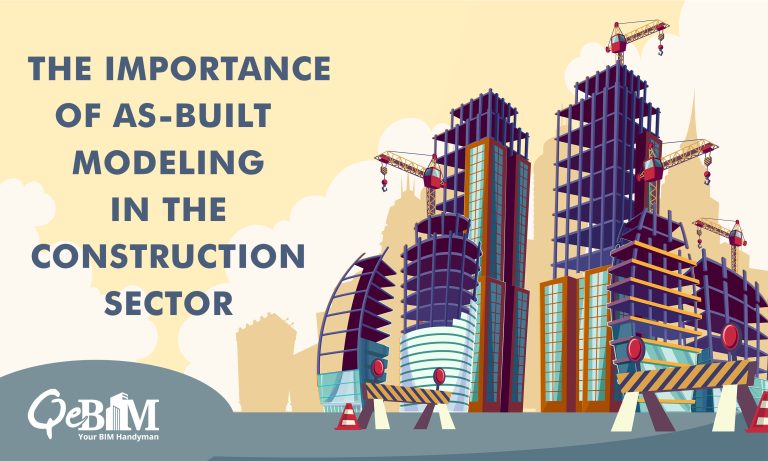The Importance of As-Built Modeling in the Construction Sector

Introduction
The construction sector is changing quickly, and technological developments are essential to improving project results. The use of Building Information Modelling (BIM) Services, which have completely changed how building projects are planned, carried out, and managed, is one such development. As-Built modelling is one of the many BIM applications that stands out for its importance. In this post, we’ll examine the value of As-Built modeling in the construction industry and emphasize its advantages for all parties involved.
Understanding As-Built Modeling
As-Built modeling is the process of producing a digital depiction of a built infrastructure or facility in use today. The actual physical and functional aspects of the project, comprising any alterations or variations performed throughout construction, must be captured and documented. BIM models provide a trustworthy source of data for the management of facilities, upkeep, refurbishment, and future growth by precisely documenting the As-Built circumstances. According to the National Institute of Building Sciences (NIBS), up to ten dollars may be conserved throughout the facility’s operating phase for every dollar spent on the development of appropriate As-Built documentation.
The Importance of As-Built Modeling
1) Accurate Documentation:
As-Built models offer a thorough account of the project’s ultimate state, guaranteeing that all alterations and adjustments made throughout construction are precisely recorded. Due to the fact that it enables stakeholders to comprehend the building’s parts, systems, and infrastructure, this documentation is priceless for future reference. These models may be used by architects, engineers, facility managers, and maintenance staff to solve problems, plan for the future, and make educated decisions.
2) Clash Detection and Coordination:
Conflicts and collisions between different building components might happen during the construction phase. As-Built BIM Services enables coordination and collision detection between several fields, including architecture, structure, and building services. Early conflict detection allows BIM service providers to promote efficient coordination and teamwork, minimizing expensive postponements and redo. This proactive method of collision identification greatly raises project quality overall and increases construction efficiency. In order to improve comprehension and interaction among architects, engineers, contractors, and clients, as-built models are used as visual representations. As-Built models boost cooperation by facilitating communication and decision-making on a common forum. They also facilitate synchronization and dispute resolution.
3) Facility Management and Maintenance:
Teams in charge of facility management and maintenance might benefit greatly from as-built models. Facility managers may speed maintenance processes, locate equipment, obtain precise specifications, and schedule maintenance tasks by combining BIM models with Computerised Maintenance Management Systems (CMMS). Through this connection, operational effectiveness is increased, downtime is decreased, and resource allocation is optimized.
4) Renovation and Retrofitting:
As-In remodeling and retrofitting projects, built modeling is essential. BIM models give architects and engineers a precise representation of the current building and its systems, making it easier to plan restorations and adjustments. Specialists can reduce unanticipated obstacles and guarantee good project outcomes if they have a repository of accurate and current data on the structure’s parts and infrastructure.
5) Cost Estimation and Value Engineering:
For activities including cost prediction and value engineering, accurate As-Built models are crucial. Contractors and estimators can precisely calculate material quantities, labor needs, and associated costs by having a thorough grasp of the project’s physical features. As a result, budgeting can be done with more accuracy and knowledge, which improves cost management and increases the viability of the project.
6) Asset Management and Lifecycle Planning:
As-Built modeling is useful for handling assets and lifecycle forecasting after the building phase. The graphical representation of the built environment may be used by facility administrators and managers to automate asset monitoring, organizing space, and upkeep tasks. As-Built models help decision-makers make better decisions about improvements to machinery, alternatives, and improvements, resulting in the optimum performance and lifespan of an asset.
7) Disaster Preparedness and Safety:
As-Built models aid in safeguarding and catastrophe preparedness efforts. Emergency response teams may more effectively prepare for evictions, accessible pathways, and crucial utility shut-offs by giving a precise picture of the building’s architectural attributes. As-Built models also help in the detection of possible risks or weaknesses, facilitating the application of proactive mitigation measures.
The Role of BIM Services Providers:
Engaging skilled BIM Service Providers is crucial to ensuring the precision and dependability of As-Built models. These service providers are skilled at gathering precise data throughout the building phase and turning it into trustworthy digital representations. They make use of cutting-edge tools like laser scanning, photogrammetry, and surveying by drones to take accurate measurements and produce top-notch As-Built models.
Conclusion
As-Built modeling is extremely significant in the construction industry and helps all parties engaged in a project’s lifespan. As-Built models facilitate informed decision-making, lower mistakes, and increase overall project productivity. They may be used for correct documentation, clash detection, facility management, refurbishment planning, quality assurance, compliance, and cost projection. Construction companies may guarantee the generation of accurate and thorough As-Built models that serve as a useful asset throughout the project’s lifecycle by cooperating with knowledgeable BIM service providers.